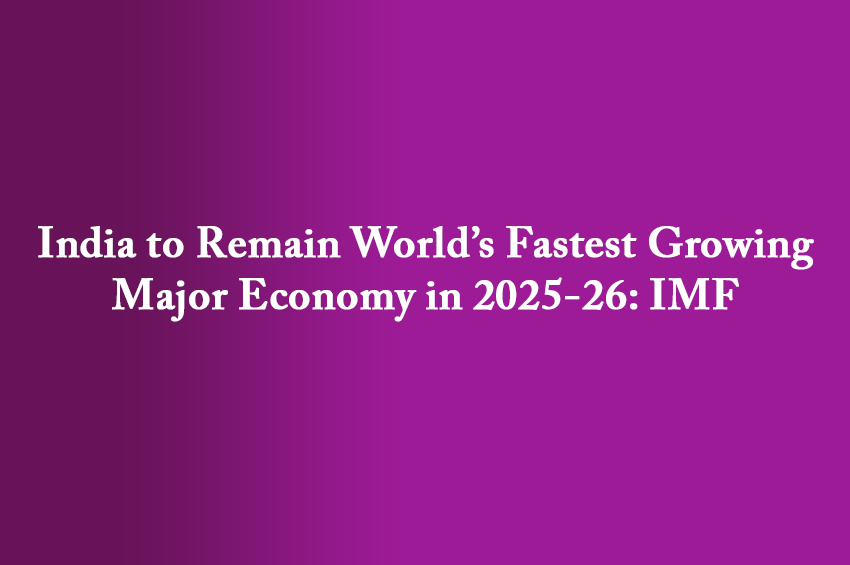Winning Bizness Economic Desk
The International Monetary Fund (IMF) has said that it expects India to remain as one of the world’s fastest growing economies in 2025-26. The IMF is also projecting a 6.6 per cent growth rate, according to its World Economic Outlook report released just a few days ago.
The report credits India’s first-quarter (Q1) performance and resilient domestic demand for the upward revision.
India’s growth trajectory continues to stand out among emerging markets, the IMF said, with the economy likely to outpace China which is expected to expand by a much lower 4.8 per cent.
An important point to note here is that India’s domestic drivers, particularly consumption and investment, are seen as keeping growth steady despite a slowing global economy.
The global economy is projected to expand by 3.2 per cent in 2025, observed the International Monetary Fund’s October 2025 update. It also stated that it would slide southward marginally to 3.1 per cent in 2026.
Growth levels remain weaker than before the recent wave of trade restrictions as many countries now attempt to combat rising protectionism, supply-chain shifts and subdued consumer demand in advanced markets.
The United States’ growth rate is expected to decline from 2.4 per cent in 2024 to 1.9 per cent while Japan and Canada are likely to register only modest growths of 1.1 per cent and 1.2 per cent, respectively.
Spain, a European and advanced economy, is expected to lead with a 2.9 per cent growth while Brazil in south America is likely to register a growth in its output by 2.4 per cent, supported by steady commodity exports and domestic demand.
India’s government has maintained its GDP growth forecast between 6.3 per cent-to-6.8 per cent for 2025-26. This broadly aligns with the International Monetary Fund’s assessment.
The country’s economy grew by 6.5 per cent in 2024-25 while Q1 of 2025-26 witnessed an impressive 7.8 per cent growth. This strong start has increased confidence in India’s ability to stay resilient amid the present global economic challenges.
India’s Forex Reserves Increase to USD 702.28-bn for Week Ended Oct 17
The country’s foreign exchange reserves increased by USD 4.496-billion to reach USD 702.28-billion for the week ended October 17, data from India’s central bank, the Reserve Bank of India (RBI) showed.
In the previous week, the reserves had moved northward by USD 2.176-billion to USD 697.784-billion.
The Foreign Currency Assets (FCAs), the biggest component of the reserves, however, slid southward by USD 1.692-billion to USD 570.411-billion during the week.
FCAs include the effects of appreciation or depreciation of non-US currencies such as the Euro, Pound and Yen held in the reserves, the RBI data showed.
The value of gold reserves climbed up sharply by USD 6.181-billion to USD 108.546-billion, marking a big increase and reflecting both price movements in the global bullion market and possible valuation gains due to dollar weakness.
Special Drawing Rights (SDRs) with the IMF also moved northward by USD 38-million to USD 18.722-billion while India’s reserve position with the IMF declined by USD 30-million to USD 4.602-billion.
A point to be noted here is that the country’s reserves have hovered near record highs, strengthening macro-economic stability and providing ample cover for imports and external debt obligations.
Crisil Says Indian Leather Exports to Slide in FY 26 Because of US Tariffs
Crisil Ratings has said that revenue inflows of Indian leather and allied products companies will slide southward by 10-to-12 per cent this fiscal (FY 26) following the steep 50 per cent tariffs imposed by the United States (US).
An important point to note here is that the US is a major market for domestic leather companies.
Given the significant export concentration, companies would register a decline despite a moderate improvement in domestic demand following the rationalisation of the Goods and Services Tax (GST) and other favourable macro-economic factors.
“The leather and allied products industry in India will see revenue decline 10-12 per cent on-year this fiscal as the 50 per cent tariff imposed by the US will slash export volume,” Crisil pointed out.
“Leather and allied products industry is estimated to have logged a revenue of about Rs 56,000-crore in fiscal 2025 and exports accounted for about 70 per cent of the revenue pie,” it said.
Here, it is important to point out that a large chunk of exports was to the European Union (EU) of over 50 per cent and the US (about 22 per cent), it added.
Signs of a decline in US export demand were already visible with the 25 per cent reciprocal tariff taking effect in the first week of August.
The additional 25 per cent punitive tariff has put India at a further disadvantage vis-à-vis other major exporting nations such as Cambodia, Italy, Vietnam and France where the US tariffs are much lower at just 15-to-20 per cent.
GST 2.0, Festive Demand Leads to Record Two-Wheeler Sales in October
The roll-out of GST 2.0 has given a big impetus to the country’s two-wheeler market, with vehicle registrations in October of this year touching 1.85-million units. This is the highest monthly tally so far this year, according to data from Vahan.
This steep increase reflects the combined effect of the recent GST rate rationalisation and robust festive season demand, which has considerably perked-up consumer sentiment across both urban and rural markets.
Many industry analysts believe that the government’s action of slashing GST (Goods and Services Tax) on motor-cycles up to 350 cc from 28 per cent to 18 per cent under the GST 2.0 framework has lowered prices considerably.
A point that requires highlighting here is that this has encouraged buyers to make their purchases ahead of the Diwali festival.
In the previous month of September, the country’s two-wheeler manufacturers had already exhibited signs of recovery, clocking a nine per cent Year-on-Year (YoY) growth in dispatches and crossing the two-million mark, propelled by festive buying and tax cuts.
Hero MotoCorp, India’s largest two-wheeler manufacturer has registered a five per cent increase in wholesale volumes, while registrations moved northward 19 per cent in September.
Another company Honda Motorcycle and Scooter India (HMSI) clocked a small three per cent increase to 5,05,000 units while TVS Motor Company registered a 12 per cent increase in volumes to 4,13,000 units, helped by strong scooter sales.
Pune-based Bajaj Auto’s dispatches climbed up five per cent to 2,73,000 units and Royal Enfield posted the sharpest growth at 43 per cent with 1,13,000 units.
Analysts point out that the festive season has helped boost demand momentum and the combination of GST cuts, new model launches and festive offers has helped perk-up consumer sentiment. This has resulted in a strong growth in two-wheelers, three-wheelers and commercial vehicles.
Diwali Retail Sales Hit Record Rs 5.4-lakh-cr: CAIT
India’s retail sector registered a massive surge in business during this year’s Diwali season. During this period, traders pan-India achieved sales worth around Rs 5.4-lakh-crore in goods, along with an additional Rs 65,000-crore in services.
This strong performance reflected the robust consumer confidence, festive enthusiasm and the growing success of domestic products amid the continued boycott of Chinese-made goods, said the Confederation of All India Traders (CAIT).
This year’s Diwali sales have surpassed all previous records, marking a steep northward climb over the Rs 4.25-lakh-crore festive business seen in 2024.
The steep increase was propelled by strong participation from both metropolitan and Tier 2 and Tier 3 markets where consumer spending remained buoyant, noted CAIT.
The extended festive period—from Navaratri and Dussehra to Diwali has also helped sustain momentum across key sectors such as jewellery, electronics, clothing, home décor and food products.
Consumer sentiment remained upbeat despite inflationary pressures as retailers offered heavy discounts, combo deals and `vocal for local’ branding to attract footfalls.
The key growth drivers were festive optimism, the impact of `vocal for local’, category expansion and regional participation.
Here, it must be highlighted that the retail boom was not confined to just the metros—for example, Kolkata’s Diwali and Kali Puja shopping touched Rs 17,000-crore, up 16 per cent over last year. This clearly reflects the rising demand in regional markets.
Industry sectors that clocked growth included jewellery, electronics, home and lifestyle and local handicrafts.
Gold and silver sales dominated Dhanteras and this was supplemented by high wedding-related demand as well. Around eight per cent of festive spending came from the electronics category, as consumers upgraded appliances and gadgets.
Three other segments also clocked brisk sales—these were furniture, home décor and kitchenware as consumers invested in refurbishing homes ahead of the festival season.
Another important highlight was the increased preference exhibited for local artisans’ products which helped perk-up small and micro enterprises, including traditional lamp-makers and craftspeople.


